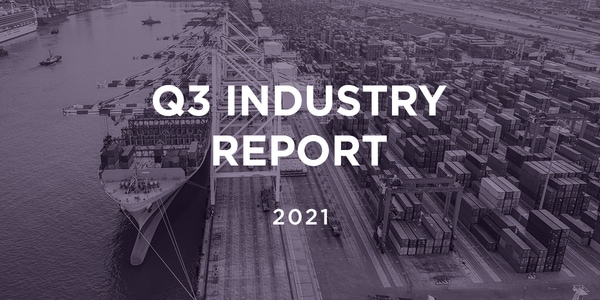
As we head into the fall months, the holiday season has come upon us. We are almost two years into the COVID-19 pandemic, and supply chains across the globe are still trying to make up ground lost and meet the demand of increased online shopping. The economy is underperforming, and there is still an uncertainty what the holidays will bring. As you prep for 2022 and the end of the year, take a look at what the data is showing.
Need to catch up? Read our reports from earlier in the year
The Q3 economic outlook
After lackluster economic growth in the Q2, economists are predicting slow growth numbers to come out of the Q3 economic reports. The current trends are leading economists to predict that US Real GDP Growth will slow to 5.5 percent (annualized rate) in Q3, continuing a troubling trend of slow economic growth we’ve seen since the start of the year. The September jobs report also missed expectations, posting only 194,000 new jobs, far off of the expectations of 500,000. Unemployment dropped to 4.8%, but this drop is being attributed to people dropping out of the workforce altogether.
Supply chain disruptions and concerns are lingering and consumer confidence is still high by historical levels, but it has dropped numerous times over the last few months. The index has fallen 19.6 points from its recent peak of 128.9 in June.
As we head into the holiday season, experts are confident that the economy will bounce back, but lingering worker shortages and persistent closures and COVID restrictions in many states threaten to limit foot traffic in stores this year. Be on the lookout for increased e-commerce shopping, but shipping times and prices could be higher than usual due to driver shortages and tightening capacity.
Spot Rates hit high points heading into the holidays
The holidays are still weeks away, but retailers are already stocking up to meet the predicted increased demand. With ships backed up in ports, seeking workers to unload them, shipping times are up, and capacity is tightening. DAT Freight and Analytics is reporting that new and evolving supply chain bottlenecks and early holiday shipping is keeping the truckload market at record highs.
Spot Rates continued to rise in Q3, dipping only slightly in September. The Van-to-truckload ratio hit as high as 6.46 in August, the second highest point this year so far. Increases are expected this time of year, and the ratio numbers are higher than in years past.
National Spot Rates at the end of September were:
Van: $6.32
Flatbed: $3.07
Reefer: $3.23
Shipments Decrease Despite Greater Expenditures
The Cass shipments Index softened in September, falling by 4.9 percent month over month after increasing 4.8 percent in August. This is being explained through rail volumes and employment issues on top of some effects from hurricanes and Tropical Storm Ida. The data indicates that the index will rebound in Q4, but shortages of certain items (particularly semiconductors) and port congestion may cause further delays.
Despite the drop in shipments, The Cass Expenditures Index rose 32% year over year in September, slowing from the 42% growth we saw in August. Normal seasonality would have us see further increases heading into Q4, but it’s a tough comparison to make given the state of the economy and the freight delay/worker shortages we have been experiencing.
The Tonnage Index brings good news for trucking
The seasonally adjusted Tonnage Index slightly rose by 0.5 percent in August after falling 1.1 percent in July. While the increase in August was minor, it represents a huge shift in the index. This was the first increase since March of this year, which depicts a picture of the broader supply chain issues and difficulties that the trucking industry has faced for months. Driver shortages and lack of equipment issues still persist, but the trucking industry remains strong. Carriers are operating with limited drivers and equipment, so any increase in the Tonnage Index is impressive in this climate.
The non-seasonally adjusted index was 2.2 percent above the level in July. In July, the number dropped 3.2 percent below June.
Diesel Fuel Prices
Diesel fuel prices continued their inevitable climb throughout Q3, a 10-month trend that has increased prices and costs for carriers and shippers alike. Diesel fuel prices increased by six cents from July to September, bring them to a level that is 76 cents higher than they were in January of this year. There is no indication this trend will reverse as we head into the end of the year.
Finish strong with King
As we head into the holidays and prepare for the uncertainties that 2022 will bring, stay up to date on the latest trends with King. We can help you prepare your supply chain against potential delays, increased costs, and any other risks that can throw off your operations in the coming months.







 Joel Rice
Joel Rice